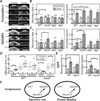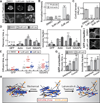Mechanical stress and network structure drive protein dynamics during cytokinesis
- PMID: 25702575
- PMCID: PMC4348339
- DOI: 10.1016/j.cub.2015.01.025
Mechanical stress and network structure drive protein dynamics during cytokinesis
Abstract
Cell-shape changes associated with processes like cytokinesis and motility proceed on several-second timescales but are derived from molecular events, including protein-protein interactions, filament assembly, and force generation by molecular motors, all of which occur much faster [1-4]. Therefore, defining the dynamics of such molecular machinery is critical for understanding cell-shape regulation. In addition to signaling pathways, mechanical stresses also direct cytoskeletal protein accumulation [5-7]. A myosin-II-based mechanosensory system controls cellular contractility and shape during cytokinesis and under applied stress [6, 8]. In Dictyostelium, this system tunes myosin II accumulation by feedback through the actin network, particularly through the crosslinker cortexillin I. Cortexillin-binding IQGAPs are major regulators of this system. Here, we defined the short timescale dynamics of key cytoskeletal proteins during cytokinesis and under mechanical stress, using fluorescence recovery after photobleaching and fluorescence correlation spectroscopy, to examine the dynamic interplay between these proteins. Equatorially enriched proteins including cortexillin I, IQGAP2, and myosin II recovered much more slowly than actin and polar crosslinkers. The mobility of equatorial proteins was greatly reduced at the furrow compared to the interphase cortex, suggesting their stabilization during cytokinesis. This mobility shift did not arise from a single biochemical event, but rather from a global inhibition of protein dynamics by mechanical-stress-associated changes in the cytoskeletal structure. Mechanical tuning of contractile protein dynamics provides robustness to the cytoskeletal framework responsible for regulating cell shape and contributes to cytokinesis fidelity.
Copyright © 2015 Elsevier Ltd. All rights reserved.
Figures




Similar articles
-
Cytokinesis: Robust cell shape regulation.Semin Cell Dev Biol. 2016 May;53:39-44. doi: 10.1016/j.semcdb.2015.10.023. Epub 2015 Oct 19. Semin Cell Dev Biol. 2016. PMID: 26481973 Free PMC article. Review.
-
A mechanosensory system governs myosin II accumulation in dividing cells.Mol Biol Cell. 2012 Apr;23(8):1510-23. doi: 10.1091/mbc.E11-07-0601. Epub 2012 Feb 29. Mol Biol Cell. 2012. PMID: 22379107 Free PMC article.
-
Contractility kits promote assembly of the mechanoresponsive cytoskeletal network.J Cell Sci. 2019 Jan 16;132(2):jcs226704. doi: 10.1242/jcs.226704. J Cell Sci. 2019. PMID: 30559246 Free PMC article.
-
Mechanosensing through cooperative interactions between myosin II and the actin crosslinker cortexillin I.Curr Biol. 2009 Sep 15;19(17):1421-8. doi: 10.1016/j.cub.2009.07.018. Epub 2009 Jul 30. Curr Biol. 2009. PMID: 19646871 Free PMC article.
-
On the mechanism of cleavage furrow ingression in Dictyostelium.Cell Struct Funct. 2001 Dec;26(6):577-84. doi: 10.1247/csf.26.577. Cell Struct Funct. 2001. PMID: 11942612 Review.
Cited by
-
Chemical and mechanical stimuli act on common signal transduction and cytoskeletal networks.Proc Natl Acad Sci U S A. 2016 Nov 22;113(47):E7500-E7509. doi: 10.1073/pnas.1608767113. Epub 2016 Nov 7. Proc Natl Acad Sci U S A. 2016. PMID: 27821730 Free PMC article.
-
Myosin IIB assembly state determines its mechanosensitive dynamics.J Cell Biol. 2019 Mar 4;218(3):895-908. doi: 10.1083/jcb.201806058. Epub 2019 Jan 17. J Cell Biol. 2019. PMID: 30655296 Free PMC article.
-
Cytokinesis: Robust cell shape regulation.Semin Cell Dev Biol. 2016 May;53:39-44. doi: 10.1016/j.semcdb.2015.10.023. Epub 2015 Oct 19. Semin Cell Dev Biol. 2016. PMID: 26481973 Free PMC article. Review.
-
Particle-based model of mechanosensory contractility kit assembly.Biophys J. 2022 Dec 6;121(23):4600-4614. doi: 10.1016/j.bpj.2022.10.031. Epub 2022 Oct 22. Biophys J. 2022. PMID: 36273263 Free PMC article.
-
Recent advances in cytokinesis: understanding the molecular underpinnings.F1000Res. 2018 Nov 26;7:F1000 Faculty Rev-1849. doi: 10.12688/f1000research.16502.1. eCollection 2018. F1000Res. 2018. PMID: 30542616 Free PMC article. Review.
References
-
- Engl W, Arasi B, Yap LL, Thiery JP, Viasnoff V. Actin dynamics modulate mechanosensitive immobilization of E-cadherin at adherens junctions. Nat Cell Biol. 2014;16:587–594. - PubMed
Publication types
MeSH terms
Substances
Grants and funding
LinkOut - more resources
Full Text Sources
Other Literature Sources

